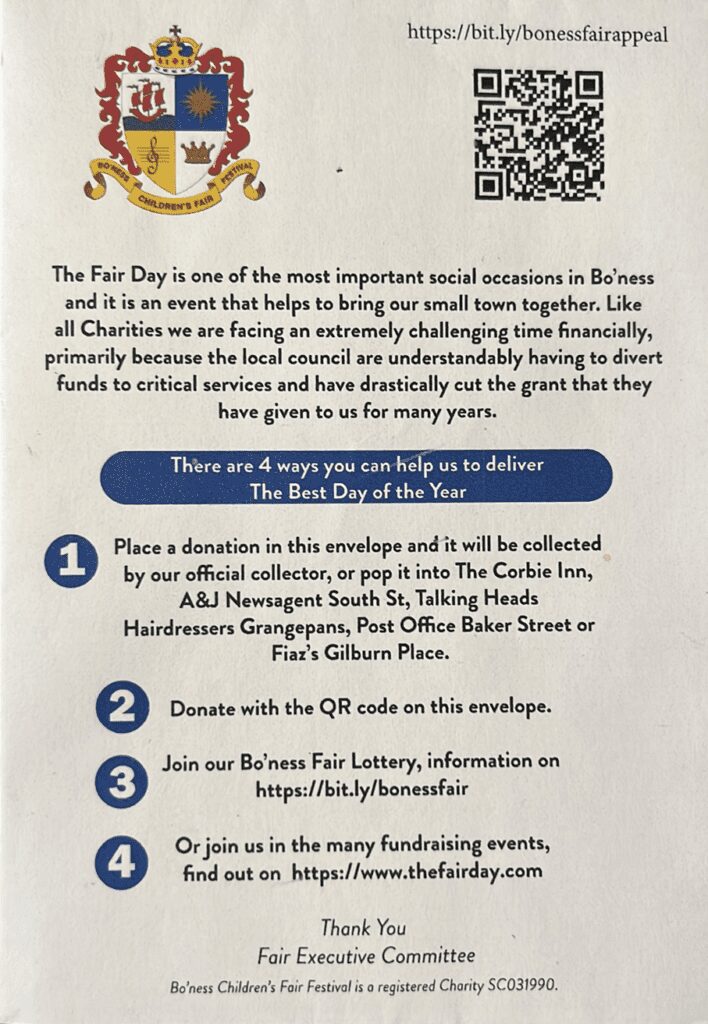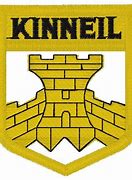IN common with many other towns in Scotland who celebrate an annual festival or community event, such as Lanark with its Lanimers Day and Lerwicks Up Helly Aa, Bo’ness celebrates its famous Children’s Fair Festival which was brought about by a visit of the then Provost Stewart to Lanark.
The ‘ Fair ‘ was originally a Miners’ Day to commemorate their freedom from bondage by an Act of Parliament in 1779 and the children and schools were introduced into the celebrations in 1897 to give the event some respectability as all too often the adults celebrated with a little over the eight.
The most spectacular feature of the Fair is the crowning ceremony which takes place in the Glebe Park at 11 a.m.
The Queen and her retinue are chosen from a different primary school each year and each school provide the fairies and flower girls that add to the splendour on the platform stage. Also representing each school are groups of presentees who perform a set piece to music and are a great attraction and entertainment for all.
After the crowning ceremony follows the procession and the children are transported in decorated floats, supplied by various industries and businesses even from neighbouring towns, to the Douglas Park where an afternoon of entertainment is provided including national as well as local talent.
The Bo’ness Fair is a time for meeting friends, relations and compatriots from all over the world who come here to enjoy one of the best Children’s Days in the Country.
Apart from promoting and featuring one of the most successful Children’s festivals in the country Bo’ness also has a lot of other attractions to offer both its inhabitants and visitors.
Borrowstounness or Bo’ness as it is known today is a town steeped in history and tradition. Situated on the southern banks of the River Forth approximately eighteen miles from the capital city of Edinburgh and eight miles from South Queensferry with its famous bridges and just three miles south is the historical town of Linlithgow, a Royal Burgh. This being the birthplace of Mary Queen of Scots with its Palace and peel beside the lovely Loch. Sir Walter Scott described the place of Linlithgow in the following words.
Of all the places so fair, Built for Royal dwelling, In Scotland far beyond compare, Linlithgow is excelling.
Geographically we could not wish for a more stimulating environment as the entire coastline of the Firth of Forth has a beauty of its own, and the outlook from Bo’ness is a panorama. Kincardine, Stirling and beyond and directly across the Forth, Culross nestling beneath the rolling Ochil Hills and to the east, Dunfermline, all places of romance and beauty.
Perhaps the earliest documented inhabitants of the Bo’ness area were the Romans during the military occupation of much of the British Isles. Evidence of the crusade is still traceable today, where they built their Forts across Scotland to defend their territory against raids from the wild northern Caledonians. There is an outline of one locally, just west of Kinneil House and it is thought that there may be one in the Bridgeness/Carriden area of the town.
The line of the Antonine Wall or Grims ( Grahams ) Dyke from Kinneil to Bridgeness is followed by Dean Road and Grahamsdyke Road. It is interesting to note in the light of all this some of the present place names in Bo’ness such as Pennelton Place which translates as ‘ the town at the end of the wall’, i.e. Kinneil at the end of Graham’s Dyke.
Since coal was mined in Bo’ness probably for the first time in Europe about the twelfth century the town has a unique and varied industrial history of which coal was the basis. Until the eighteenth century much of the coal was used for the manufacture of salt by the evaporation from sea water. Salt pans were conspicuous along the shore from Corbiehall to Grangepans until the end of the nineteenth century.
In the late 1700s James Watt experimented with the steam engine and Dr Roebuck brought him to Kinneil in hope that he could produce a steam pump to rid his pits of water. Thus began Bo’ness’s part in the industrial revolution. 1779 was the year the Miners’ were freed from bondage from their masters and Bo’ness miners celebrated by marching to the Palace of Kinneil, as it was then known, – from this march arose the Miners’ Gala Day, the only one day holiday in the year for the ordinary people. There were sports and horse racing on the foreshore and this continued until 1897 when it gave way to the Children’s Fair Festival which over the years has gained international recognition with Children from all over Europe, U.S.A., Australia and Canada participating in the event. It is not to be assumed from the foregoing that Bo’ness is a community which dwells in the past although we are justifiably proud of our traditions and history.
Bo’ness can boost many up to date facilities such as a recreation centre with modern equipment, a Library with Prestel connections and computer retrieval system and conference facilities to name but a few.
Bo’ness has a lot to offer visitors. There is Kinneil Estate situated in the west of the town comprising of some 80 hectares. At the time of take over by Falkirk District Council, Bo’ness Town Council instigated the renovations of the adjacent buildings which now form Kinneil Museum and the Duchess Ann cottages so called because those buildings were built in the 18th century by Ann the Duchess of Hamilton. The renovation received a Saltire Society and National Heritage award and are certainly worth a visit.
Kinneil Estate has played an important part in the past Children’s Fair Festivals where all the afternoon facilities used to take place. It has also seen the crowning of the Fair Queen in front of Kinneil House.
Some years ago a Bo’ness Heritage Trust formed with the purpose of the preservation of the industrial heritage of of the Forth Valley town which otherwise might be lost forever. They are also guardians of a large collection of communication equipment and it is hoped to mount an exhibition on the history of communications through out the year in the Hippodrome building within the town centre.
A listed building, the Hippodrome was built as a cinema in 1911. This building was recently purchased by the Trust and will will be used to exhibit lots of photographs etc., about Bo’ness in the years gone by.
Another great attraction to the town for locals and visitors alike is the S.R.P.S. Bo’ness and Kinneil Railway. There you can take a seven mile trip on a steam train to Birkhill Clay Mine. In the clay mine you can journey through the tunnels of underground workings and see what it was like to work underground, mining fireclay. You will also discover the uses for the fireclay and note that without it the industrial revolution may never have taken place.
Also at the Station is Hamilton’s cottage and a visit there is a must to find out how a working man lived during the early 1920s.
Bo’ness is a town much loved by its people with a strong and active community spirit. Its history is that of the Scottish industrial revolution in miniature. The town, though neglected for generations, still retains its relics of a more prosperous past when pride, independence and industry combined to furnish it with a unique collection of buildings.
The architecture of Bo’ness is a varied as the history of the town.
The older buildings are largely concentrated in the old town centre at sea level beyond which, to the south, the land rises fairly steeply in terraces. On the first of these are the houses and villas of the merchants of the 19th century.
To the east of the town is Carriden House dating from 1692 with its extensive grounds and glen. The house itself is built in the Scottish baronial style and was the seat of Lord Bargany. It is now a Bed and Breakfast establishment and is popular with foreign tourists.
In the centre of the town there are a number of buildings worth note. One such building is the Anchor Tavern built in 1891. In South Street, the Old Tolbooth is an excellent piece of renovation and conservation work and Bridgeness tower at the east end of the town, which, since it was built in the 1700s, has seen service as a windmill, observatory, the manufacturing of Sulphuric Acid, flats and has now been renovated into a beautiful and unique dwelling house.
I hope that I have kindled the interest of visitors to our old town and that they will think of making their visit to the ‘ Fair ‘ an extended one and spend a few days exploring the beauty and places of interest in and around the area which I am sure they will find fascinating and worthwhile.
I wish everyone a happy and memorable Fair Day.
WILLIAM RODGER, J.P.






